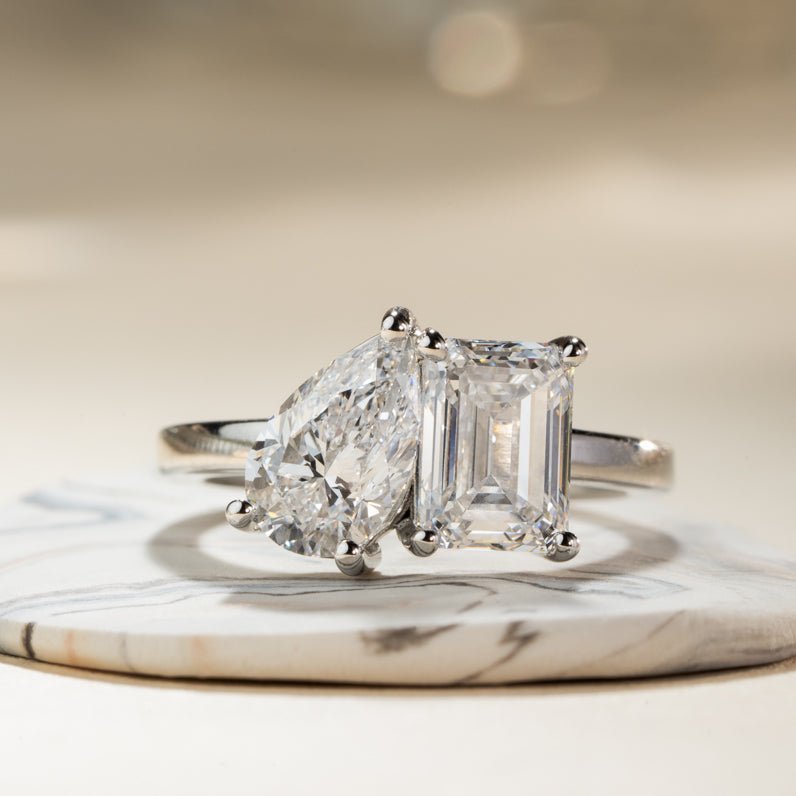When you hear diamond clarity, do you picture a complex scientific chart and lots of numbers? While that’s just one part of it, it’s more like “How visible are the diamond’s tiny quirks?” And yes, every diamond has them—just like every human has pores, or an awkward driver’s license photo. It’s basically the diamond’s unique fingerprint.
Key Takeaways
-
Cut > Clarity: Brilliance isn’t killed by a tiny inclusion; it’s the cut that makes your diamond light up the room.
-
Price Reality Check: Clarity scale has less impact on price than you think. Don’t blow your budget chasing “flawless.”
-
Perfectly Imperfect: Many inclusions are invisible to the naked eye. They only matter if you have a lab-grade microscope.
-
Lab vs. Natural: Lab diamonds can have fewer inclusions, but both lab and natural diamonds are ethically sourced at Malleable.
Malleable Jewellers is Canadian-made, Fairmined-certified, carbon-neutral and a proud B-Corp. Plus, everyone who works for Malleable is paid above the Toronto living wage; to maintain this, we’re part of the Ontario Living Wage Network. So yes: we care about what’s inside our diamonds and where they come from, like our lives depend on it (because they kind of do…)
How the Diamond Clarity Scale Is Graded
Diamond grading for clarity is a microscope-and-expert process. Professional graders inspect the stone (often at 10x magnification) and note the size, number, position, and visibility of any internal marks. That result becomes the clarity grade, shorthand for how “perfect” the diamond looks under magnification and to the naked eye. Fun fact: the grade has less impact on the diamond’s price than you think.
Inclusions vs. Blemishes: What’s the Difference?
Here’s the tea: inclusions happen inside a diamond. Think freckles, birthmarks, or a secret tattoo no one knows about. Blemishes, on the other hand, live on the surface—like that time you threw your phone in your bag and your keys scratched the screen. And yes, diamond inclusions and blemishes are actual diamond industry terms and not something we made up! Also, doesn’t it feel kinda good to know that even diamonds have blemishes?
Neither one automatically makes a diamond “bad.” In fact, inclusions can be proof that your stone is natural, not mass-produced. It’s like saying, This is one-of-a-kind. And because we work with both mined and lab-grown diamonds, we’ll help you understand exactly what those little quirks mean for the look, durability, and value of your gem.

Diamond Clarity Grading Scale: From Flawless (FL) to Included (I3)
The official diamond grades and clarity system runs on a scale created by the Gemological Institute of America (GIA), an independent non-profit. Here’s the TL;DR:
-
FL/IF (Flawless/Internally Flawless):
-
Unicorn-level rare. Almost no one actually sees these inclusions.
-
-
VVS1–VVS2 (Very Very Slightly Included):
-
You’ll need magnification stronger than your last Zoom call filter.
-
-
VS1–VS2 (Very Slightly Included):
-
Tiny quirks, still hard to spot.
-
-
SI1–SI2 (Slightly Included):
-
Some inclusions you might notice if you squint hard enough.
-
-
I1–I3 (Included):
-
More visible inclusions. Not worse, just more “diamond with personality.”
-
At Malleable, we’ll never pressure you to chase Flawless. We care more about whether the diamond looks stunning to the naked eye and whether it’s ethically sourced.
How the Diamond Clarity Scale Affects Brilliance and Sparkle
Here’s where reality kicks in: inclusions don’t always kill a diamond’s sparkle. In fact, brilliance has more to do with cut than clarity. Yep, it’s the angles and light reflection—the diamond brilliance rating—not the “imperfections” that decide whether your diamond blinds someone across the room.
Still, a heavily included diamond might look a little cloudy. This is why we have an in-house HRD-certified diamond grader to assess the stones. HRD is the Hoge Raad voor Diamant Antwerp, a European diamond certification authority based in Belgium, assessing its quality based on the 4Cs (Carat, Colour, Clarity, and Cut), and other factors like finish and fluorescence. Our jewellers will guide you on the sweet spot of the diamond clarity scale: maximum sparkle, minimal budget stress. Because nobody needs a diamond that looks like it’s been through 2020.
Do Lab Diamonds Have Fewer Inclusions?
Ah, the great debate: lab diamond inclusions vs. natural inclusions. Here’s the scoop:
-
Lab diamonds can have fewer inclusions because we grow them in controlled environments.
-
Natural diamonds form under pressure (literally, billions of years underground), so inclusions are part of their origin story.
Both are gorgeous. Both can shine like a TikTok ring-light. And at Malleable, both are traceable, sustainable, and ethically sourced. Because sparkle without conscience is just… glitter.
Choosing the Best Diamond Clarity Scale for Your Budget
The million-dollar (or hopefully not million-dollar) question: which diamond clarity price is right for you?
-
If you want “flawless flex” for your engagement ring, sure, go high.
-
If you’d rather invest in a killer cut or bigger carat size, the clarity scale is where you can compromise. And let’s be honest, they are still gorgeous diamonds.
-
If you’re unsure, book a video consultation or come to our Toronto studio in person. We’ll walk you through real stones, not stock photos, so you can see the differences yourself.
Remember: sometimes “slightly included” is code for “no one but your jeweller under the microscope will ever notice.”
Find the Diamond that Speaks to You with Malleable
We’re not a big-box diamond brand with vague sustainability and conflict claims… We’re a certified B-Corp, Fairmined-certified, carbon-neutral, and part of the Ontario Living Wage Network. This means that every piece of jewellery you buy supports fair pay, ethical, sustainable, traceable sourcing, and products hand-made right here in Canada. Curious to know more about our process and sourcing? Check out our FAQ.
Ready to see which diamond clarity scale makes your heart (and ring finger) happy? Book a consultation or explore our signature collections.
Written for Malleable by Delta Growth and Sonya Gankina







